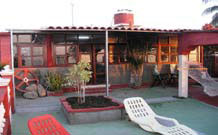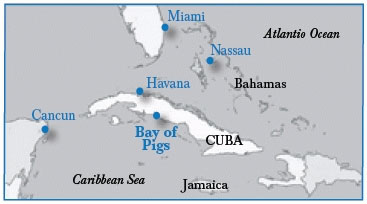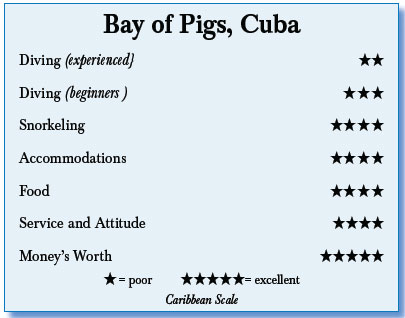The Bay of Pigs, CubaContents of this Issue: Curacao, Fiji, Papua, Maui . . . PADI Stonewalls Dead Diver’s Family How to Insure Your Dive Equipment Does Breathing Nitrox Reduce Post-Dive Fatigue? A Divemaster’s Thoughtful Rant The Divemaster’s Take on Tipping Need a Fish, Coral or Critter ID Book? Editorial Office: Ben Davison Publisher and Editor Undercurrent 3020 Bridgeway, Suite 102 Sausalito, CA 94965 easy living, easy diving, maybe even for Americans from the April, 2011 issue of Undercurrent
Dear Fellow Diver: The six-lane highway from Havana to the Bahia de los Cochinos (Bay of Pigs) has light traffic as I motor along in a VW rental car, a model I'm not familiar with. There's Cuban salsa on the radio, and crops and open fields along the roadside. Old American cars that give Havana a look of my youth are still in evidence on this two-hour trip. I just left the lively capital, where I heard a lot of music, did a lot of walking and drank too much rum, and am headed for the island's south (Caribbean) side and a much slower pace. The Bay of Pigs is more famous for the failed 1961 U.S.- sponsored invasion than for its wall diving. My dive group had chosen the spot not for its history but for its coral reef (which, back in 1960, the CIA reportedly interpreted as floating seaweed in its aerial photos, thus losing some of its invading ships to the coral heads). With three friends, I arrive at the little dive shop in Playa Larga, at the head of the long, narrow bay, to make sure we are set for diving the next morning. Not a cloud in the sky, and it will stay that way for most of the next week. Pepe Allejua, who I plan to dive with, is not at the shop but someone says come back at 8:30 am tomorrow, which we do. Minutes after choosing tank sizes, I am told to follow the shop's van in my car to the first site.
At a site called El Tanque, I step off the limestone shore and swim slowly over the sand flats and back reef. The goldspot and bridled blennies scatter, but a pair of spotfin butterflies swims with me, one on each side. A peacock flounder stirs, as striped goatfish scavenge the sand, with a bar jack hoping to share their harvest. The shallows at all sites are excellent snorkel areas, and at this site, a busload of tourists arrive during our diving to greet us overhead when we return. (I didn't see any divers or snorkelers at other sites.) At about 20 feet, the coral slopes to
the lip of a vertical wall at 40 feet. I
cruise along slowly at 70 feet, enjoying the
healthy coral sprouting purple rope sponges.
The fish life is sparse, so I focus on the
oysters and occasional lobsters, and find several green tube tunicates. A school of
Creole wrasse pours over the wall above me, and Pepe points to a distant barracuda.
They are never eaten here, due to ciguatera poison concerns, but are not common. I
head up a sand chute to a wrecked fishing boat Pepe had called the "Cuban Titanic" in
his 30-second dive briefing. He points to a big black grouper lurking under it. Near
the wreck is a field of at least 100 garden eels, neatly spaced and waving gently to
nab tiny morsels. I peer into the boat's hold to watch sharpnose puffers paddle aimlessly.
Now on the shallow back reef, we angle back to the starting point. I follow a
beautiful red-tail parrotfish; why are the terminal males so pretty in these waters? I
find my first lionfish of the dive, under a big coral head; they are in evidence on all
dives, though Pepe says they only arrived a year ago. I spy a shy hamlet ducking behind
a coral. I'm staying in Casa Mesa, a "casa particular" (Cuban for bed and breakfast ) right on Playa Larga's beach, one of several standing side by side. Casa Mesa is $25 per person plus a little more for breakfast; good dinners are $10. It has two simple rooms to rent in the modest home, with the modern amenities of hot water in private bath, A/C and a mini-fridge, as well as nice sitting areas shared by guests. You can also stay at the inexpensive hotels in Playa Larga or Playa Girón, the two towns that book-end the Bay of Pigs. My friends are three houses down from Casa Mesa, and we eat together, alternately at one house then the other. Tonight it's lobster with yucca root in mojo (a lemon-garlic sauce), "cristianos y moros" (black beans in rice), and the inevitable fruit plate. And Bucanero beer for me. This is Cuban home cooking and plenty of it. On mornings, I sip good Cuban coffee in the dining area or on the patio. Mauret brings fresh papaya juice and a fruit plate, and asks how I want my eggs. Roberto gets out a bicycle for two and heads off with his daughter to school. I am asked when we want dinner, with a choice of fish, lobster, pork or chicken. Life is smooth and easy in the slow lane. In my five days here, a few others will pass through, staying in the other room. Only one couple are divers; I spend time sharing rum on the patio with them.
All dives were shore dives with a swim to
the wall, 200 to 300 feet out. Some sites have
small dive shops with gear and tanks on site,
but usually tanks are loaded into a van at the
main dive shop at 8:30 a.m. and driven to the
site. Although Pepe said we could do three dives
per day, their setup is designed for two: You
go to the right on the wall, then left, for two
dives at each site. The 12- and 15-liter steel
tanks were filled from 2,700 to 3,000 psi(12
liters has a little more capacity than an aluminum
80). I chose the whopper but didn't need it; the profile puts you on top of the wall
or in the back reef for nearly half the
dive time. Although we could stay down
well over an hour, my group was usually
back in 50 minutes. Currents are negligible,
and the water was 80 degrees in
February. Pepe, like the Cuban divemasters
I have met on other trips, was competent,
safety conscious and spoke good
English. He gave extra help to an inexperienced
diver in our group. However,
the briefings were slim and his knowledge
of reef life is modest. At Punta Perdiz, I giant stride off a six-foot drop, and, enjoying the sun, I swim on my back 300 feet to near the wall. I descend in 20 feet of water amidst big coral heads, some almost to the surface. A mottled goatfish lazes next to me. Soon I'm soaring over the wall into blue water. I ease down to the depth of the blackcap basslets, and use my light to check out the holes. At 80 feet, we enter a swim-through, coming out at 110 feet, cruising from the tunnel into the blue. The visibility is excellent and the sun makes the big scenery just right. Another swim-through puts me into a sand chute and past an uninteresting wreck. (One can dive on wrecked landing craft from the 1961 invasion, but I didn't.) I enjoy the shallows with a greater variety of fish life than along the wall. My partner is finding bizarre inverts; she picks up some weird mollusk, which definitely is not in the Paul Humann book. There are plenty of dead staghorn and elkhorn, but a fair amount of live patches and a bright yellow-green finger-shaped coral that I cannot identify. Under one patch, I find three blue-phase sergeant majors chasing away grunts from their egg patches. These proud papas are so agitated they look like nervous wrecks. A four-foot barracuda, the largest fish I've seen, cruises just inches over the sand. The Bay of Pigs is not the most exciting or fishiest location in Cuba, but it's good Caribbean wall diving in a very nice environment. Most divers come for a couple days as part of a longer vacation, or are bussed in for a day from Varadero, Cuba's big beach resort. Cuba's top-of-the-line diving is at Maria la Gorda in the west or Isla de la Juventud (Isle of Youth) to the south; both are dedicated dive resorts. Isla de Juventud features great formations a la Cozumel and good fish life. Maria la Gorda has a good variety of sites and fish life, and would be my first choice. To get to the Isle of Youth, you take a short-hop flight from Havana. For Maria la Gorda, you can hire a driver for the four-hour ride or rent a car. -- A.M.
|

I want to get all the stories! Tell me how I can become an Undercurrent Online Member and get online access to all the articles of Undercurrent as well as thousands of first hand reports on dive operations world-wide
| Home | Online Members Area | My Account |
Login
|
Join
|
| Travel Index |
Dive Resort & Liveaboard Reviews
|
Featured Reports
|
Recent
Issues
|
Back Issues
|
|
Dive Gear
Index
|
Health/Safety Index
|
Environment & Misc.
Index
|
Seasonal Planner
|
Blogs
|
Free Articles
|
Book Picks
|
News
|
|
Special Offers
|
RSS
|
FAQ
|
About Us
|
Contact Us
|
Links
|
3020 Bridgeway, Ste 102, Sausalito, Ca 94965
All rights reserved.


 While I found the breadth of fish life to be light in the Bay of Pigs, this
was not the only dive in which I spotted five hamlet species, an unusual variety. Back
near the shore, moon jellies pulse in six feet of water near the French-speaking snorkelers.
I'm done diving for the day at 12:30. Time to stop at the store to restock the
mini-fridge on the way to a shower, maybe take a walk, and the 3Rs: relaxing, reading
and romance. There's a shower on the patio where I'm staying. Good thing, because most
sites have no rinse tank nearby.
While I found the breadth of fish life to be light in the Bay of Pigs, this
was not the only dive in which I spotted five hamlet species, an unusual variety. Back
near the shore, moon jellies pulse in six feet of water near the French-speaking snorkelers.
I'm done diving for the day at 12:30. Time to stop at the store to restock the
mini-fridge on the way to a shower, maybe take a walk, and the 3Rs: relaxing, reading
and romance. There's a shower on the patio where I'm staying. Good thing, because most
sites have no rinse tank nearby.
 I met an
award-winning underwater photographer
named Daniel Perez the following day. As
I visited with him and admired his macro
shots, I wished he were diving with
us for help in spotting unusual critters.
We spent intervals at the beach
while Pepe and his assistant swapped the
tanks. At La Cueva de los Peces, or Fish Cave, you can take a dip in a lovely cenote
or buy a refresco at the café. Cenote diving is available and advertised.
I met an
award-winning underwater photographer
named Daniel Perez the following day. As
I visited with him and admired his macro
shots, I wished he were diving with
us for help in spotting unusual critters.
We spent intervals at the beach
while Pepe and his assistant swapped the
tanks. At La Cueva de los Peces, or Fish Cave, you can take a dip in a lovely cenote
or buy a refresco at the café. Cenote diving is available and advertised. Diver's Compass: Most travelers to Cuba go through Havana, the biggest
city in the Caribbean, which is definitely worth a few days for its
music and culture . . . I stayed in a very nice, down-home "casa particular"
called Casa Mercedes González (e-mail
Diver's Compass: Most travelers to Cuba go through Havana, the biggest
city in the Caribbean, which is definitely worth a few days for its
music and culture . . . I stayed in a very nice, down-home "casa particular"
called Casa Mercedes González (e-mail 